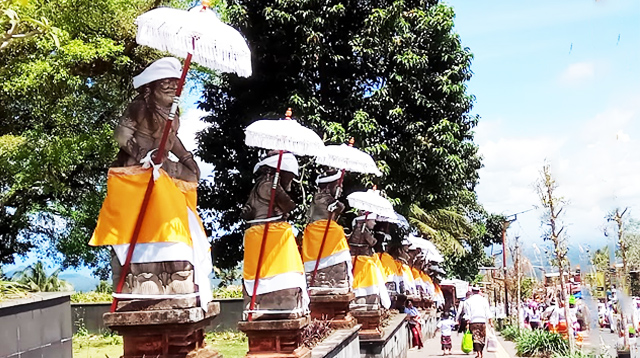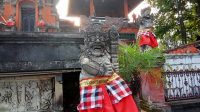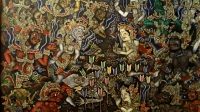TOURIST destination of Bali Island presenting the beauty of nature also acts as a living canvas that unites art and spirituality. In every corner, from magnificent temples to remote villages, you will find religious statues that are not only beautiful, but also hold ancient stories, deep philosophies, and invisible energies.
These are not just stone or wood carvings; they are manifestations of spirits, guardians of traditions, and gateways to understanding the rich culture of Bali. Let’s explore how this art becomes the heart of the Island of the Gods, captivating the eyes and souls of every visitor.
Among the various forms of art that thrive, religious sculpture occupies a central position, becoming guardians of tradition, incarnations of myths, and bridges to spirituality. These statues are not just decorations; they are manifestations of spirits, carved stories, and guardians of sacred areas that radiate invisible energies.
Stories of Gods and Heroes in Physical Form
Religious sculpture in Bali is deeply rooted in the Hindu Dharma mythology believed by the majority of its people. Each sculpture is a visual narrative of ancient stories passed down through generations. We can find representations of the Trimurti – Brahma (the Creator), Vishnu (the Preserver), and Shiva (the Destroyer) – in various distinctive attitudes and attributes. A statue of Ganesha, the elephant-headed god who is intelligent and brings good fortune, often greets the entrance of a temple or house.
Not only the main gods, various other mythological entities such as Garuda (the vehicle of the great God Vishnu), nagas (symbols of prosperity and guardians of nature), or various forms of guardian giants (dwarapala) with scary faces but function as protectors, are also widely manifested in the form of statues.
Each statue carries its own story; the statues of Barong and Rangda, for example, embody the duality of good and evil that are inseparable in life. Seeing these statues is like reading the pages of the Puranas (Hindu holy books about ancient stories) in three dimensions, a way to understand the universe and the role of the gods in it through symbols that can be sensed.
Symbolism in Every Stroke
Behind its visual beauty, Balinese religious sculpture contains incredible philosophical depth. Every detail, from the hand position (mudra), the attributes held, to the facial expressions, has a deep symbolic meaning. For example, the statue of Goddess Saraswati holding a veena symbolizes knowledge and art. The statue of Lord Vishnu riding Garuda symbolizes the maintenance of the universe which is manifested through movement and balance.
The philosophy of Tri Hita Karana—the concept of harmony between humans and God (Parhyangan), humans with fellow humans (Pawongan), and humans with nature (Palemahan)—is deeply reflected in the placement and design of the statues. Statues are often placed in strategic places that are believed to have spiritual power, such as in temples, at crossroads as a ward against disaster, or near water sources as guardians of purity. The presence of statues is a constant reminder of the spiritual principles that must be maintained in everyday life, a visualization of dharma (truth) and karma (actions and their consequences).
Serenity, Awe, and Respect
Psychologically, religious sculpture has a powerful effect on individuals. The presence of statues of deities or guardians carved with detail and strong expressions can evoke feelings of reverence and awe. For Balinese Hindus, looking at these statues is a form of mediation, a way to connect with the divine energy they represent. This clear visualization helps in concentration and absorption of spiritual values.
Even for non-believers, these statues often evoke a sense of peace and serenity. The symmetrical forms, intricate details, and spiritual aura emanating from their presence in sacred areas can trigger feelings of awe at the beauty of art and the power of belief.
Seeing old statues covered in moss and placed under the shade of a shady banyan tree can give rise to goosebumps, a sense of the presence of the sacred and untouched by time. These statues serve as visual anchors that link the mind to the spiritual dimension, inviting introspection and self-reflection.
Overall Harmony
Religious sculptures in Bali are not just individual objects; they are an integral part of the aesthetic landscape of sacred areas, especially temples. Their placement is carefully considered to create a harmonious and meaningful visual composition. Temple entrances (candi bentar and kori agung) are often decorated with magnificent guardian statues, serving as both physical and spiritual gateways. Statues of deities are placed an in the pelinggih (holy place) according to the cardinal directions and their functions.
The use of natural materials such as tuff, wood, and sometimes bronze, combined with traditional architecture and tropical vegetation, creates an aesthetic that is organic and at one with nature. Moss growing on old statues adds texture and a sense of timelessness. All elements—buildings, vegetation, water, and statues—are harmonized to create a space that is not only visually beautiful, but also spiritually sacred, facilitating the implementation of ceremonies and prayers. This aesthetic is the embodiment of the balance between sekala (the visible) and niskala (the invisible).
Gateway to the Heart of Balinese Culture
For tourists, Balinese religious sculpture is a major attraction that should not be missed. It is an authentic gateway to understanding the heart of Balinese culture and spirituality. Visiting large temples such as Pura Besakih, Pura Tanah Lot, Pura Ulun Danu Beratan, or Pura Tirta Empul, tourists will be presented with a collection of magnificent and meaningful statues.
Many local sculptors also open their galleries or workshops, allowing tourists to see firsthand the intricate and detailed process of creating their sculptures. This is a valuable opportunity to interact with the artists, understand the philosophy behind their work, and even purchase a sculpture as a souvenir of artistic and cultural value.
Tourists can also take cultural tours that focus on sculpture, or even join a small sculpting workshop to experience the traditional Balinese art for themselves. These experiences are not only a feast for the eyes, but also enrich the soul, providing a deeper understanding of the spiritual and artistic Bali. This is an offering that is different from just a beach trip or a night out, an invitation to delve into the depths of a civilization that values beauty and sanctity in every aspect of its life. (*)










